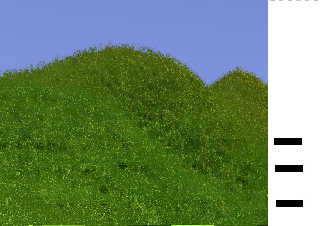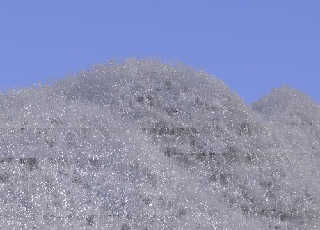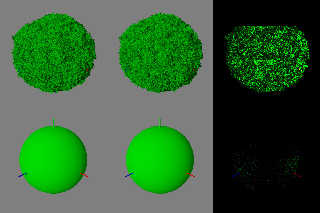 |
 |
|
 |
|
 |
|  |
|  |
|
 |
|
 |
|  |
|  |
|
 |
Op 12/08/2020 om 09:39 schreef Ton:
> What you could try to do is render the whole scene non-stop with +ec0.25, so it
> doesn't take so long, and see whether that difference still shows up. That way
> you are sure it is the +c.
>
Yes, I was going to do that indeed. See also my answer to Bill.
--
Thomas
Post a reply to this message
|
 |
|  |
|  |
|
 |
|
 |
|  |
|  |
|
 |
This is the other issue I mentioned above. Here the isosurface simulates
vegetation. At the bars'levels, I stopped the render and restarted with
+c. A boundary is visible from the exact point of start onwards.
No media used here; just the isosurface.
The green image with a complex slope texture.
The grey image with a simple pigment. I restarted three times there too;
can you see them? ;-)
--
Thomas
Post a reply to this message
Attachments:
Download 'continueissue.jpg' (87 KB)
Download 'continueissue_grey.jpg' (62 KB)
Preview of image 'continueissue.jpg'

Preview of image 'continueissue_grey.jpg'

|
 |
|  |
|  |
|
 |
|
 |
|  |
|  |
|
 |
On 8/13/20 3:59 AM, Thomas de Groot wrote:
> This is the other issue I mentioned above. Here the isosurface simulates
> vegetation. At the bars'levels, I stopped the render and restarted with
> +c. A boundary is visible from the exact point of start onwards.
>
> No media used here; just the isosurface.
>
> The green image with a complex slope texture.
> The grey image with a simple pigment. I restarted three times there too;
> can you see them? ;-)
>
I do indeed. Aside from the continuity on continuations issue those
results look pretty good for quick vegetation, frosted vegetation. :-)
I await the test scene.
Bill P.
Post a reply to this message
|
 |
|  |
|  |
|
 |
|
 |
|  |
|  |
|
 |
Op 13/08/2020 om 13:47 schreef William F Pokorny:
> On 8/13/20 3:59 AM, Thomas de Groot wrote:
>> This is the other issue I mentioned above. Here the isosurface
>> simulates vegetation. At the bars'levels, I stopped the render and
>> restarted with +c. A boundary is visible from the exact point of start
>> onwards.
>>
>> No media used here; just the isosurface.
>>
>> The green image with a complex slope texture.
>> The grey image with a simple pigment. I restarted three times there
>> too; can you see them? ;-)
>>
> I do indeed. Aside from the continuity on continuations issue those
> results look pretty good for quick vegetation, frosted vegetation. :-)
My original image seems to be definitely due to an uncontrolled change
to the code by me. I was misled by this present issue apparently.
Yes, this makes up for an interesting vegetation indeed. However, it is
not fast of course.
>
> I await the test scene.
Posted the scene in p.t.scene-files.
--
Thomas
Post a reply to this message
|
 |
|  |
|  |
|
 |
|
 |
|  |
|  |
|
 |
On 8/14/20 2:20 AM, Thomas de Groot wrote:
> Op 13/08/2020 om 13:47 schreef William F Pokorny:
...
>>>
>>> The green image with a complex slope texture.
>>> The grey image with a simple pigment. I restarted three times there
>>> too; can you see them? ;-)
>>>
>> I do indeed. Aside from the continuity on continuations issue those
>> results look pretty good for quick vegetation, frosted vegetation. :-)
>
> My original image seems to be definitely due to an uncontrolled change
> to the code by me. I was misled by this present issue apparently.
>
> Yes, this makes up for an interesting vegetation indeed. However, it is
> not fast of course.
>>
>> I await the test scene.
>
> Posted the scene in p.t.scene-files.
>
Thank you.
Is it easy to post one or both of the simpler isosurface fuzzy
vegetation scenes too. I was thinking I would start there over the
complete scene.
Trying your scene currently in v3.8 master and the first thing I notice
is the radiosity blocks on continuation appear to be generated just
short, below the position where the render re-starts. Do you see
something similar?
Aside: Suppose I would have expected those looking to continue renders
to save radiosity results (photon results) to a file? Maybe I'm not
running the right flags with your scene. I didn't look at it that
closely as yet...
See the scene is using f_bicorn() which I dumped from povr so I have
that too in the way of a quick 'is it the shadow cache bugs.' More if/as
I figure more out.
Bill P.
Post a reply to this message
|
 |
|  |
|  |
|
 |
|
 |
|  |
|  |
|
 |
On 8/14/20 7:34 AM, William F Pokorny wrote:
...
> See the scene is using f_bicorn() which I dumped from povr
...
Ignore this bit. Just clicked this is me running my development povr2
and not a correctly configured povr. I was picking up the wrong
functions.inc which has f_bicorn in it.
Bill P.
Post a reply to this message
|
 |
|  |
|  |
|
 |
|
 |
|  |
|  |
|
 |
On 8/14/20 7:34 AM, William F Pokorny wrote:
...
>
> Is it easy to post one or both of the simpler isosurface fuzzy
> vegetation scenes too. I was thinking I would start there over the
> complete scene.
>
Hold off. I now have something simpler running in povr showing
differences on continuations, but seeing other issues too. Perhaps
jitter related. Need to sort it out, but but render turns fast so
hopefully can get to some better understanding.
Bill P.
Post a reply to this message
|
 |
|  |
|  |
|
 |
|
 |
|  |
|  |
|
 |
On 8/14/20 9:18 AM, William F Pokorny wrote:
> On 8/14/20 7:34 AM, William F Pokorny wrote:
> ...
>
> Hold off. I now have something simpler running in povr showing
> differences on continuations, but seeing other issues too. Perhaps
> jitter related. Need to sort it out, but but render turns fast so
> hopefully can get to some better understanding.
>
OK. You found a continuation bug with radiosity (non saved).
Using my current povr and after turning jitter off somewhat easy to see
you can use continuation when using just lights, but not with radiosity.
The top row in the attached image is a foliage like isosurface sphere
which matches perfectly up to the first continuation. I stopped and
restarted roughly every render block row. I used a multiplier of 15 for
the isosurface image differences.
In the second row of the image I used a regular sphere, but used a
multiplier of 60 for the image differences. The issue is there with all
shapes, it's just harder to see on something like a sphere.
If I get fired up maybe I'll try saving radiosity samples (couldn't get
it to work trying quickly...). An outside chance that might fix it, but
given the circular patterns we see on the sphere, I suspect there is
some sort of offset in the sampling pattern on continuation. A bug no
matter saved samples or not - good find.
Bill P.
Post a reply to this message
Attachments:
Download 'continuestory.jpg' (279 KB)
Preview of image 'continuestory.jpg'

|
 |
|  |
|  |
|
 |
|
 |
|  |
|  |
|
 |
Op 14/08/2020 om 13:34 schreef William F Pokorny:
> Is it easy to post one or both of the simpler isosurface fuzzy
> vegetation scenes too. I was thinking I would start there over the
> complete scene.
Late but sorry, I should have been more explicit. Both isosurfaces
Isoveg and Isorock are there at the bottom of the scene; just
comment/uncomment the one you need.
>
> Trying your scene currently in v3.8 master and the first thing I notice
> is the radiosity blocks on continuation appear to be generated just
> short, below the position where the render re-starts. Do you see
> something similar?
Yes, but I assume that depends on the pretrace_end size. Change that to,
e.g. 0.004, and the gap is much smaller, controlled by that size value.
>
> Aside: Suppose I would have expected those looking to continue renders
> to save radiosity results (photon results) to a file? Maybe I'm not
> running the right flags with your scene. I didn't look at it that
> closely as yet...
Well, I never save radiosity data (in contrast to photon data of course)
so I would not know.
>
> See the scene is using f_bicorn() which I dumped from povr so I have
> that too in the way of a quick 'is it the shadow cache bugs.' More if/as
> I figure more out.
>
> Bill P.
--
Thomas
Post a reply to this message
|
 |
|  |
|  |
|
 |
|
 |
|  |
|  |
|
 |
Op 14/08/2020 om 16:16 schreef William F Pokorny:
> On 8/14/20 9:18 AM, William F Pokorny wrote:
>> On 8/14/20 7:34 AM, William F Pokorny wrote:
>> ...
>>
>> Hold off. I now have something simpler running in povr showing
>> differences on continuations, but seeing other issues too. Perhaps
>> jitter related. Need to sort it out, but but render turns fast so
>> hopefully can get to some better understanding.
>>
>
> OK. You found a continuation bug with radiosity (non saved).
>
> Using my current povr and after turning jitter off somewhat easy to see
> you can use continuation when using just lights, but not with radiosity.
>
> The top row in the attached image is a foliage like isosurface sphere
> which matches perfectly up to the first continuation. I stopped and
> restarted roughly every render block row. I used a multiplier of 15 for
> the isosurface image differences.
>
> In the second row of the image I used a regular sphere, but used a
> multiplier of 60 for the image differences. The issue is there with all
> shapes, it's just harder to see on something like a sphere.
>
> If I get fired up maybe I'll try saving radiosity samples (couldn't get
> it to work trying quickly...). An outside chance that might fix it, but
> given the circular patterns we see on the sphere, I suspect there is
> some sort of offset in the sampling pattern on continuation. A bug no
> matter saved samples or not - good find.
>
Right! I shall try on my side to see if there is a difference when
radiosity data is saved in the scene.
--
Thomas
Post a reply to this message
|
 |
|  |
|  |
|
 |
|
 |
|  |




![]()